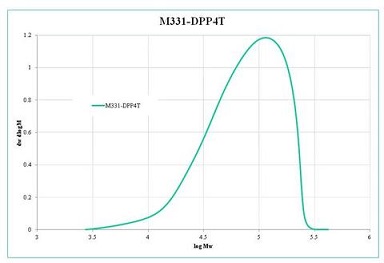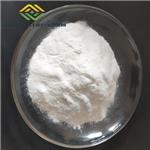Classification
Quaterthiophene, Heterocyclic five-membered ring, Organic semiconducting materials, Low band gap polymers, Organic photovoltaics, Polymer solar cells, OFETs.
Characterisation
Soxhlet extraction was carried out using methanol, acetone, hexane and then chlorobenzene as washing solvents under argon. Chlorobenzene fraction was concentrated, precipitated with methanol, and dried under vacuum at 40 oC for 48 hours. GPC was carried out using 1,2,4-trichlorobenzene as eluent at 140 oC by using polystyrene as standards.
 Molecular weight distribution of PDPP4T chlorobenzene Soxhlet fraction from GPC analysis.
Molecular weight distribution of PDPP4T chlorobenzene Soxhlet fraction from GPC analysis.
Applications
PDPP4T, also known as DPP4T, Poly[2,5-bis(2-octyldodecyl)pyrrolo[3,4-c]pyrrole-1,4(2H,5H)-dione -3,6-diyl)-alt-(2,2’;5’,2’’;5’’,2’’’-quaterthiophen-5,5’’’-diyl)] is a promising class of semiconducting polymers for organic solar cells. This is due to its small optical band gap and high charge-carrier mobility.
DPP4T has one DPP unit as electron-withdrawing and four five-membered thiophene as electron-rich units in its backbone, resulting a low-band gap polymer semiconductor with planar structure. The alkyl chain attached to DPP unit not only serves as a high-solubilising group, but also has a tendency to crystallise to ensure a better packing film. Due to its electron-rich and planar structure with the capacity of forming well-packed films, DPP4T has been reported exhibiting a hole mobility greater than 1 cm2 V-1 s-1 in top-contact bottom-gate devices.
By using a solvent swelling assisted sequential deposition (SSA-SD) method to produce bulk heterojunction PSCs based on a crystalline diketopyrrolopyrrole (DPP) polymer and PC71BM, Device performance PCE of 7.59% with a VOC of 0.61 V, JSC of 17.95 mA/cm2 , and FF of 69.6%, is reported with PC71BM as electron acceptor. Also by adding polymers like DPP-DTT with high mobility, device performance with higher PCE should be expected.
Synthetic Route
DPP4T was synthesised by using 3,6-bis(5-bromothiophen-2-yl)-2,5-bis(2-octyldodecyl)pyrrolo[3,4-c]pyrrole-1,4(2H,5H)-dione and 5,5'-bis(trimethylstannyl)-2,2'-bithiophene as starting materials via Stille Coupling polymerisation in chlorobenzene. Targeted polymer was purified using Soxhlet extraction with methanol, acetone, hexane and finally chlorobenzene as washing and extracting solvents.

PDPP4T synthesis via a Stille Coupling reaction with 3,6-bis(5-bromothiophen-2-yl)-2,5-bis(2-octyldodecyl)pyrrolo[3,4-c]pyrrole-1,4(2H,5H)-dione and 5,5-bis(trimethylstannyl)-2,2-bithiophene as starting materials.
Description
PDPP4T, also known as DPP4T, Poly[2,5-bis(2-octyldodecyl)pyrrolo[3,4-c]pyrrole-1,4(2H,5H)-dione -3,6-diyl)-alt-(2,2’;5’,2’’;5’’,2’’’-quaterthiophen-5,5’’’-diyl)] is a promising class of semiconducting polymers for organic solar cells. This is due to its small optical band gap and high charge-carrier mobility.
![Poly{2,2'-[(2,5-bis(2-octyldodecyl)-3,6-dioxo-2,3,5,6-tetrahydropyrrolo[3,4-c ]pyrrole-1,4-diyl)]dithiophene-5,5'-diyl-alt-2,2'-bithiophene-5,5'-diyl} Structure](https://www.chemicalbook.com/CAS/20211123/GIF/1267540-03-3.gif)


